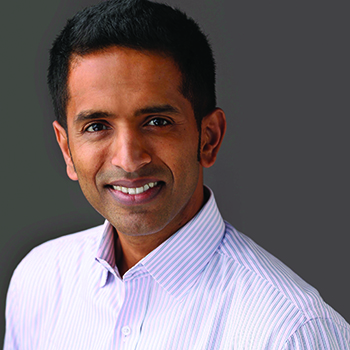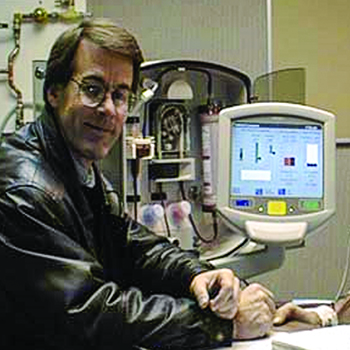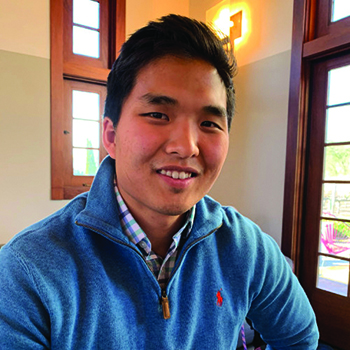For every virus, ailment, and disease that exists, there are scientists who believe they can unlock its secrets and change lives. But it takes knowledge, good questions, capital, the right people, and a lot of time to go from an idea to a safe, marketable solution. The confidence, conviction, and sometimes craziness of many Wabash alumni are moving the biotechnology landscape forward.
Each came to Wabash for a different reason.
Rod Kenley ’72 was introduced to Wabash by the drummer in his high school band.
Paul Radspinner ’85 was headed to a state school, but while at a track meet was prompted by Coach Rob Johnson H’77 to visit campus.
Alex Burgin ’86 knew he wanted to attend a small school and was drawn to the opportunity to get a great education and continue his swimming career.
Dushyanth Surakanti ’98 felt comfortable on the campus in his hometown where several of his friends were also attending. 
Jason Kwon ’11 was drawn to the other similarly curious minds.
Once on campus, the physical and metaphorical space of Wabash allowed them to grow.
Now, these alumni are well-established scientists and entrepreneurs in biotechnology. They got there by asking smart questions, knowing how to find answers, and bringing together the resources and teams of people who can generate solutions to treat and cure chronic diseases.
“I didn’t know how big the world was. In the confines of campus, I was exposed to so many things,” says Surakanti, founder and CEO of Sparta Biomedical. “Part of the learning was not only academic. Wabash established in me how to be resourceful.
“I remember a meeting I had with Biology Professor David Polley. I asked him about a certain problem. He looked at me and said, ‘How long did you spend looking this up and really trying to solve it before you came into my office?’ I said I had spent a long time but I knew that he knew I was totally full of it.”
Surakanti says the company is driven by asking, “Why not?” instead of saying, “It can’t be done.”
“Everyone has a voice at the table,” he says. “Everyone listens. Everyone is head cook and bottle washer.”
“I wanted to go after really big problems,” he continues. “That led me to explore starting my own thing with technologies that can be profoundly impactful—not necessarily being a physician myself with one patient, but enabling many physicians with a therapeutic.”
Sparta Biomedical has developed a construct that mimicks cartilage. The first application of the product is geared toward people suffering from osteoarthritis in the knee. Over time they will expand to other joints.
“[Founders of biotech startups] fall into this bucket of entrepreneurs who have a very, very high level of conviction—to a point where maybe it’s neurotic,” Surakanti says. “It’s a combination of having enough experience, but not so much experience that you can only think one way and do it one way.”
Surakanti’s reality check is simple.
“I ask, ‘Would I recommend this for my dad or mom?’” he says. “If I can answer, ‘Absolutely, yes,’ then I know that I’m working on the right thing.”
Kwon credits the introduction to genetics course as influential in his desire to pursue his Ph.D. He is a postdoctoral fellow in molecular genetics at the Dana Farber Cancer Institute at the Broad Institute. His research, recently published in Nature, focuses on more than a quarter of all cancers.
“There are these conceptual latent ideas—information embedded within genetics that derive the consequential nature of all phenotypes in organisms,” he says. “That was mind blowing. I was hooked. My further research with faculty at Wabash gave me the tools to know how to think about science, hypothesis generation, and testing.”
 Radspinner is now president and CEO of FluGen Inc. His company is developing a universal flu vaccination to address issues of consistent efficacy, annual virus drift, and shedding. Long-term plans include using similar technologies for COVID-19 prevention.
Radspinner is now president and CEO of FluGen Inc. His company is developing a universal flu vaccination to address issues of consistent efficacy, annual virus drift, and shedding. Long-term plans include using similar technologies for COVID-19 prevention.
“This business is brutal when it comes down to it because you’re doing science. There’s no guarantee what the outcome is going to be,” he says. “You can have all kinds of predictors, but in the end, you do a clinical trial, and you are literally sitting there waiting for the results. It could be the end of the company, or it could be every vaccine company is going to want to buy it tomorrow.
“We haven’t experienced the former and, unfortunately, haven’t experienced the latter yet,” Radspinner continues. “It’s the potential to make a significant difference that keeps me going every day.”
For Burgin, it’s the constant challenge in his work that keeps him motivated.
“Drug discovery is incredibly hard. It is one of the things I love about it. It requires an understanding of chemistry, physics, biophysics, and organismal biology,” says the senior director of the Center for the Development of Therapeutics at the Broad Institute in Boston. “When you’re a young scientist especially, there can be a lot of defeat—criticism you take submitting a paper, or getting the hell beat out of you on a grant that’s completely rejected. It takes a lot of strength. But it’s worth it.”
The Broad Institute brings researchers from MIT, Harvard University, and Harvard-affiliated hospitals together in a co-working space where they share ideas and technology, and the academic and industry scientists seek solutions in tandem. It’s a new way of bringing the two groups together under one roof.
“The model where the academic lab is part of the team is very special,” Burgin says. “I spend about half of my time trying to convince companies, venture capitalists, and granting institutions to support this new model of discovery; about a quarter of my time thinking about the science, looking at data, understanding where we’re going, what we’re doing; and the last quarter getting everybody on the same page—rowing in the right direction and excited about being here, and then recruiting and retaining the best scientists.”
Biotechnology is an aggressive space that encompasses a vast array of research and development within a market predicted by BioSpace to be $3.44 trillion by 2030. Even so, the necessary capital, even if the science is solid, can be hard to come by.
 “I hate to lose. I’m a very competitive individual,” says Kenley, who spent a few years in marketing before moving to technology development. “You’ve got to know how to develop a business plan that can persuade investors to part with their money, and you’ve got to be able to present it well.”
“I hate to lose. I’m a very competitive individual,” says Kenley, who spent a few years in marketing before moving to technology development. “You’ve got to know how to develop a business plan that can persuade investors to part with their money, and you’ve got to be able to present it well.”
Kenley now owns more than 100 patents centered on at-home kidney dialysis and the treatment of kidney disease. As the chief innovation officer at Byonyks Inc., he is part of a team building a device to cut down on waste and cost, and increase the ease and efficiency of dialysis.
In the beginning, Kenley believed in his idea and refused to give up.
“I finally got in touch with the right people and that put us on the path to getting the funding,” he says. “I was able to scrape through until that first check came in. That was a big day—when I took a million-dollar check to the bank, handed it to the cashier, and said, ‘Deposit this in my account, please.’”
Radspinner understands the volatility of research and development.
“Luckily, I was a little bit naive, because if I knew what it takes to develop a vaccine, I might not have chosen that path,” Radspinner says with a laugh. “We raised a couple million dollars just to get going in about 30 days. It shouldn’t have happened that quickly. It made me think it was really easy to raise money. The death of most small businesses, or most startups, is a lack of capital. That’s the reason most don’t make it. They overestimate sales or underestimate how difficult it is to raise capital.
“The highs are higher, the lows are lower, and they’re closer together,” he says. “One day you’ll have a setback on the clinical trial or the science. And then the next day, you’ll have a meeting with a company and then they’ll be interested in partnering, or we just got two grants worth $8 million. Those are good days.
The quick development of a COVID-19 vaccination within a year of the first documented case in humans had Radspinner getting quizzed.
“I’ve had people say, ‘Why is it taking you so long?’” he recalls. “I didn’t have a billion dollars thrown at me. Remember, at that time, every vaccine company started working on COVID.”
But he says scientists began the work on mRNA, the driver of the COVID-19 vaccination, more than 20 years ago.
“We were fortunate. If COVID had hit five years earlier, the vaccine development never would have happened that fast,” Radspinner says. “We’d probably still be trying to get a vaccine right now. In the end, it turned into a positive. We all know the history and who ended up making it across the finish line, Pfizer and Moderna. Those companies have done well. Because of that, there’s more money out there being used to work with companies like us.
“When we first started moving forward on a new universal flu vaccination, the first two candidates failed pretty quickly,” he says. “While we were pivoting, another candidate came through. It’s now in phase two clinical trials.”
The process starts with preclinical work which includes checking safety, efficacy, and toxicology. Then an Investigational New Drug (IND) application gets filed with the FDA.
“If they allow you to move forward, you run a clinical trial,” Radspinner explains. “The first thing you do is start with a low dose and work up, starting with healthy populations first, then the older adults, and eventually children all the way down to six months.
“Phase two can be a couple of things with vaccines. Our phase two was a challenge study. You get either a placebo or our vaccine,” he says. “Phase three is creating a safety database that’s large enough in each target population. That’s at least 3,000 subjects on the vaccine, and another 3,000 on a comparator or a placebo. Then manufacturing—different lots are tested to show consistency from one batch to the next.
“The average vaccine takes 15 to 20 years to get approved.”
Getting a therapeutic device to market also takes a lot of time and many layers of testing, approval, and evaluation.
“In 2018 we started the exercise of ‘Can we bring this to market?’” says Surakanti. “It has gotten to the point where we are now hoping to study in people. We are on track to file an Investigational Device Exemption (IDE) application with the FDA to start the clinical study by the end of the year to collect safety and effectiveness data. And at the end of 2026, we will file a Premarket Approval (PMA) with the FDA. If the FDA says, ‘We like what we see; you’re approved,’ we would launch in 2027.
“We get messages from people that say, ‘Please hurry. I’m in my 30s and I can’t make it to the bathroom without crutches.’ It really establishes the why—why we have been tirelessly working over the past few years to get this to market as quickly as possible.”
Every incremental step, idea, failure, and success brings with it the possibility of positively impacting lives.
“My pledge brother’s wife contracted kidney failure. She was using my home dialysis machine,” Kenley says. “I visited them and I took with me some pictures to show her how we developed it with different prototypes. She gave me feedback about what she liked and disliked. It’s really gratifying to see somebody benefiting from something I’d done—especially when it’s that close to home.”
Surakanti appreciates what the win means for the patients but also for his team.
“The most exciting aspect is the immediate restoration of mobility, significant pain reduction, and the ability for individuals to engage in their daily activities again,” says Surakanti. “As we progress toward our goal, we will be able to say we worked on something transformative and overcame numerous challenges, and we can look back and say we grew from it—technically and from each other and all of our different partners who were involved throughout.”
Success is obvious in a product that makes it to market, but Burgin recognizes the importance of celebrating every step of learning.
“Many projects fail. With biology there are a bunch of unknowns,” Burgin says. “It was a great idea, but it’s not going to work. That is actually a victory. We can show this is not a path to take. Hopefully, it’ll show us a new path.
“But we need to celebrate that as a victory as well. That’s a fundamental problem in science. There are no incentives for negative results. I take it seriously to make sure the team knows, even when the project is ending, that’s a victory. You showed there is no path forward. I wish we would have made a drug, but you know what? We’re going to help the world know not to waste your time over here.”
For Kwon, there is joy in knowing he might be onto something.
“Most days,” Kwon says, “I wake up pinching myself wondering how I could have been so lucky to have a job that I get to do what I love every day just answering questions about the unknown that no one might know but me. The ability to dream up a question and then go answer it is pure bliss for me.
“Whatever we discover has some core relevance to potentially benefit humanity,” he continues, “whether it be inspiring or informing the development of new therapeutics or simply adding to the large canon of human knowledge.”
Ultimately, few people get to this point with any project. Perseverance pays off.
“How many scientists or research assistants get to say, ‘I was involved in that vaccine that’s in the market right now’?” says Radspinner. “Believe in yourself and just keep going.”